When to Use Chatbots vs Live Chat
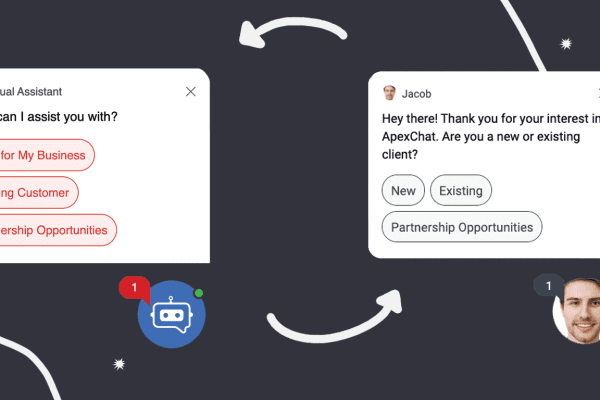
As of March 2024 we have renamed Apexchat to Blazeo. We are excited to share the next part of our journey with our customers and partners.
The name ApexChat implies that we are primarily a chat company, which is no longer true. Now we have many offerings, such as call center services, AI, Appointment setting, SMS Enablement, Market Automation, and Sales acceleration (Q2 2024), that go beyond chat. The new name will not only allow us to convey the breadth of our offering but will also better convey our company’s mission and values.
Blazeo, which is derived from the word Blaze, evokes a sense of passion, speed, and energy. A “Blaze” is captivating, illuminates, and represents explosive growth. Blazeo encapsulates our mission to ignite such growth for our customers and partners by delivering innovation with passion, speed, and energy.

What are you currently using to communicate with your customers?
If your business is only using calling, emailing, or submitting a form on your website as the only ways for your customers to reach you, you need to make some changes to your lead generation strategy.
Offering chat for your website visitors on your website is a better way to provide customer service.
Providing direct communication channels to your business has never been more important.
According to studies, 73% of consumers say live chat is their most preferred method of communication.
This ranked highest compared to other methods. In fact, 61% of consumers said they preferred email, 48% preferred social media and only 44% preferred phones.
If that wasn’t impressive already, live chat also had a 92% satisfaction rating. Live chat has the highest satisfaction rating compared to other forms of customer support.
It’s clear your business needs to offer this feature on your website. But what’s the best way to implement it? You’ve got two choices: add chatbots or live chat representatives.
Chatbots are primarily computer-generated responses. They allow customers to receive answers to their questions via AI software.
The upside with Chatbots are their scalability. They are able to handle more chats than live agents are typically able to handle.
The change in consumer experience has already begun. By 2020, 85% of consumers will be able to manage their relationships with businesses without human interaction. That number is expected to rise as businesses adapt to current digital trends.
Customer service is also seeing heavy investment in AI related technologies. In fact, 80% of businesses are either currently using AI or planning to use AI for customer service in the next two years.
Customer expectations are changing as well, with 45% of customers reporting that they prefer chatbots for customer service inquiries.
Because of these rapid changes in the market, you need to have marketing skills to survive in the age of AI.
A study by Grand View Research reports that the global market size for chatbots is expected to hit $1.25 billion by the year 2025, with a 24.3% compounded annual growth rate.
While either option is viable, you need to decide whether you will use chatbots or actual humans to type responses to customers on your website.
People ask us everyday which option is better, the reality is each option has its pros and cons.
We’ll explain when it’s best to use one over the other in this guide. We’ll cover some factors and scenarios to help you decide the best fit for your website.
Most of us have experienced slow customer service at some point in our lives.
Whether we like it or not, humans are impatient people. We’ve built up an expectation that information should be delivered to us as quickly as possible.
As a business, you don’t want to make your customers wait. That’s a big problem when it comes to customer service.
The good news is that live chat drastically reduces wait times. 79% of consumers say they prefer live chat because they get their questions answered immediately.
Additionally, according to Econsultancy, 79% of consumers say they prefer live chat functions because they don’t have to wait on hold and get their questions answered immediately.
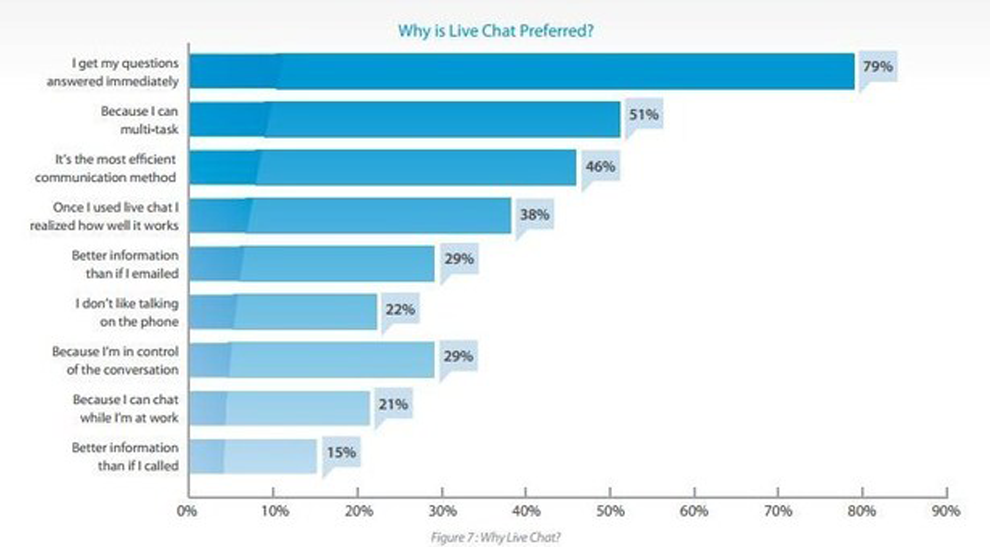

But it’s still not perfect. 21% of live chat support requests are ignored by businesses.
While live chat offers a fast response time, there are still areas that can be improved.
On the other hand, chatbots offer an instant response to your customers.
When a customer starts a chat with your business a chatbot can generate an answer within seconds. This keeps the conversation flowing and the customer is engaged right away.
If your main goal is to achieve the fastest response times, chatbots win. However, live chat will still be faster than the majority of other options you’re using.
Our recommendation is to use a combination of these two options to provide the best experience.
When a customer begins a chat on your site, use a chatbot to give them an instant reply. The bot can gather descriptive information about the customer until a representative becomes available to take over the conversation.
Chatbots should also be able to transfer the customer to the right representative who is qualified to answer their question.
We’ll discuss more about how chatbots and live chat representatives can work together further in this guide.
Every business decision should be cost-effective. Live chat will help reduce your costs compared to phone support.
Phone services are expensive. Studies show that it’s 17-33% less expensive to communicate with a customer via live chat than phone calls.
The upside to offering live chat agents is their ability to multitask and help several customers at the same time. Multitasking like this can’t be done over the phone.
Live chat will improve your operational efficiency. This all sounds good, but how much will this new technology cost you?
Live chat pricing can be confusing if your business hasn’t explored this sort of engagement channel yet. Sorting through the various price models can seem overwhelming.
Live chat pricing plans can vary substantially. Understanding how these various engagement channels are priced can help you choose the best solution for your businesses needs.
Recommended Article: A beginner’s guide to live chat pricing
The main live chat pricing models you’ll typically encounter include:
Free live chat
There are some live chat solutions that offer their live chat services for free.
While these can seem attractive initially, they are relatively bare-boned in their functionality and customizability.
For example, Olark offers a “Free Forever” plan that provides clients with a limited number of chats per month. The drawback here is that businesses that use this option are assigned only one agent and can engage with just 20 chats per month.
We strongly recommend you consider other options that offer more features and a better customer experience. The last thing you need is a live chat solution that makes your website visitors leave your website.
Pay-per-agent
Pricing will vary significantly depending on the live chat provider businesses go with and the features they need.
For example, Zoho limits the number of agents available even with the top tier plans they offer. That means your business won’t have access to more than 10 operators at the $116 per month price plan.
Another provider, Live Chat, has similar pricing tiers, in addition to a $149 per agent tier that is billed exclusively on an annual basis.
Pay-per-agent pricing is widely used throughout the live chat industry. However, the downsides are you lose out on additional features and functionality for that consistent monthly price.
Volume-based pricing
This type of pricing model is similar to pay-per-agent plans. However, the cost structures based on volume look at your website’s traffic to determine what your flat rate will be.
Volume-based pricing can be as high as $600 per month or as low as $40 monthly depending on the service.
This model can be useful for businesses who are just starting out and don’t have the website traffic to justify switching to a per-lead or per-performance model yet.
Pay-per-lead
This model charges you based on chat performance rather than a flat monthly or annual fee. So if you generate five leads in a month with live chat, you’ll only pay only for those five leads.
The price per lead can vary depending on which live chat solution you go with. PRice can range anywhere from $18 per lead to $35 per lead depending on the industry.
The upside with this model is some live chat providers qualify which leads you’re billed for.
For example, if someone provides just an email address, but does not indicate whether he or she is interested in your services, you won’t get charged for the prospect information.
In addition, performance-based pricing often includes many of the features that are covered in high-priced monthly plans such as full chat invitation customization, data reporting, chat agents available 24/7 and delivery of all chat transcripts.
Your goal with live chat for your business is to offer as good of a customer experience as possible.
You may be wondering, where do chatbots fit in this equation? Let’s take a look at where they fit in the live chat decision making process.
Outsourcing live chat services to a customer service agency will likely be cheaper, but you may lose some quality of the responses compared to those given by one of your own employees.
So how many employees will you need to handle your live chat communication?
Roughly 51% of businesses have only one live chat agent dedicated to customer inquiries. Additionally, 39% of companies have between two and five agents.
While this may seem low, it’s not surprising. About 70% of brands that implement live chat have less than 5,000 unique website visitors each month.
In many cases, price is the most important factor for these businesses when deciding to use live chat.
One way to lower these cost concerns is to implement a chatbot or virtual assistant on your website.
Virtual Assistants and Chatbots are essentially the same thing, but the functionalities of both differ depending on the provider you use.
For example, our Virtual Assistant allows you to replicate the behavior and performance of your best team members at scale.
In this case, you’ll need to pay for the software rather than live agents. But this will cost you less in the long run compared to paying employees in addition to the cost of the live chat software.
Here’s a quick overview of how live chat and chatbots compare to one another.
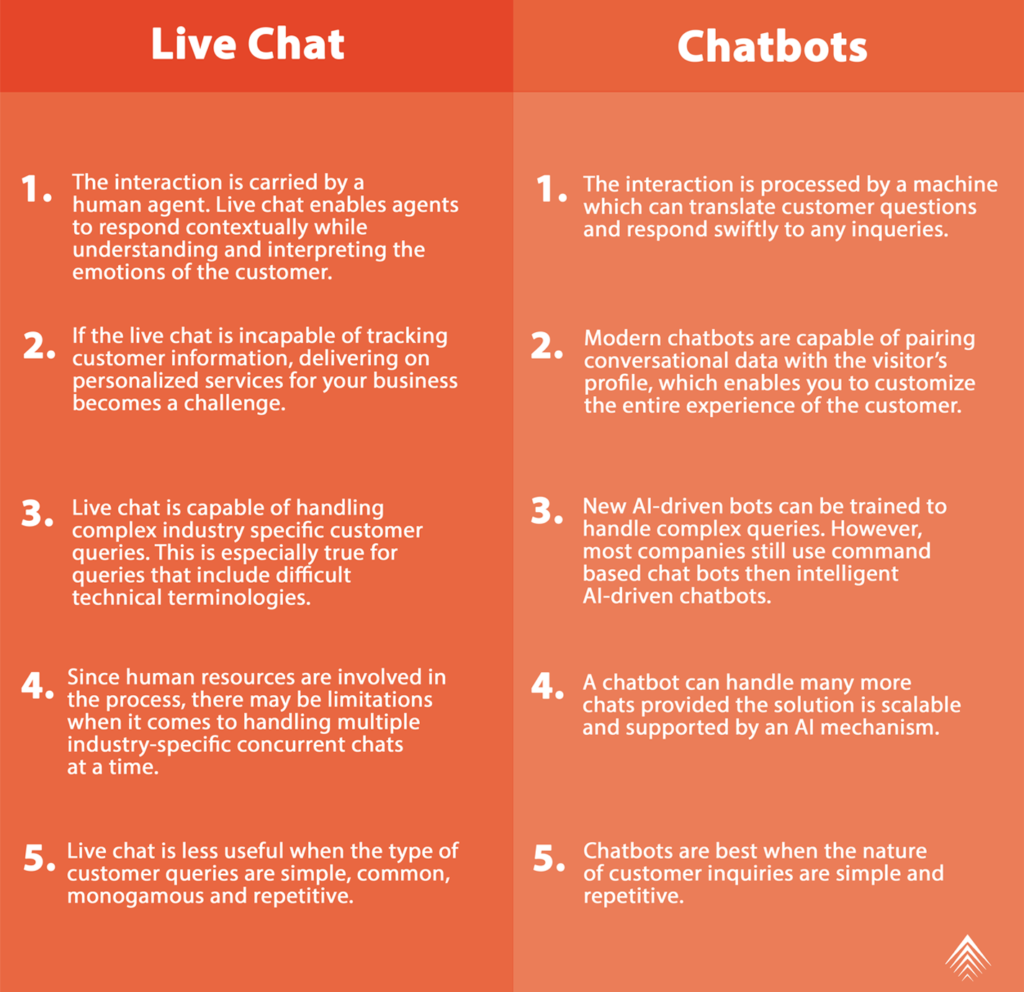

That being said, using human reps to respond via live chat is still cheaper than most phone support services.
Live chat and chatbots are both excellent tools to engage your website visitors, but there are noticeable differences between the two experiences.
Artificial intelligence is definitely advancing, some would say at a terrifying pace.
Responses by chatbots often can mimic human answers. Sometimes, customers won’t even notice they are talking to a robot.
That said, chatbots aren’t able to replace that human touch customers need when seeking information from your business.
There is still some resistance from customers when it comes to using chatbots:
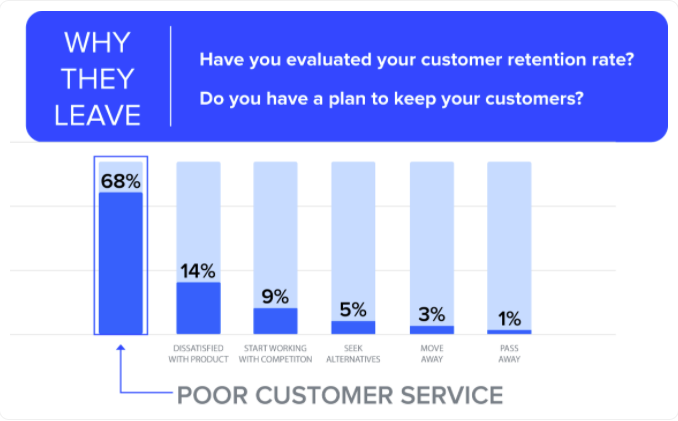

As you can see here, customers still have their reservations about using this new technology.
There are times when customers would rather speak with an actual person from your team. This is especially true for instances where they are frustrated and want someone to empathize with their situation.
Chatbots simply don’t have that ability to recognize distress like a human agent can. About 37% of consumers expect to use a chatbot for getting a quick answer in an emergency.
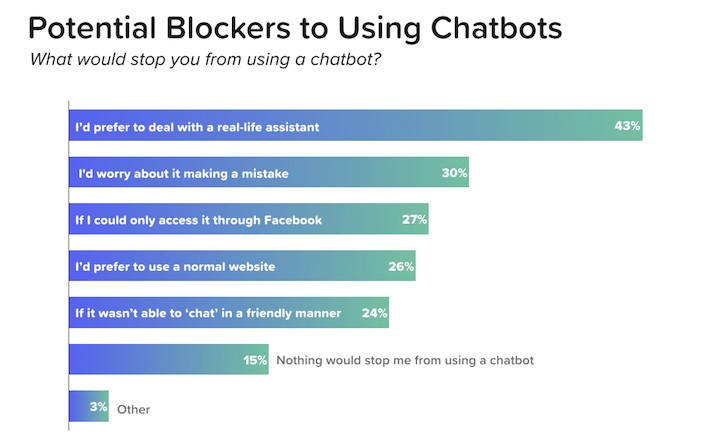

Additionally, 34% of people say they would use a chatbot to help them find a customer service associate.
This reinforces our earlier point about the two options working well together.
If you do go the chatbot/virtual assistant route, make sure that it can transfer the customer to a live chat session with an actual human.
If you plan to use an employee to handle inquiries on your website and chat with customers, they’re probably not going to be available 24/7.
Depending on your live chat provider, your costs will be significantly higher if you’re paying for human support 24/7, 365.
Most smaller businesses cannot afford this. However, there are live chat and chatbot options that can meet this need.
The number one potential benefit of using chatbots is 24-hour customer service.
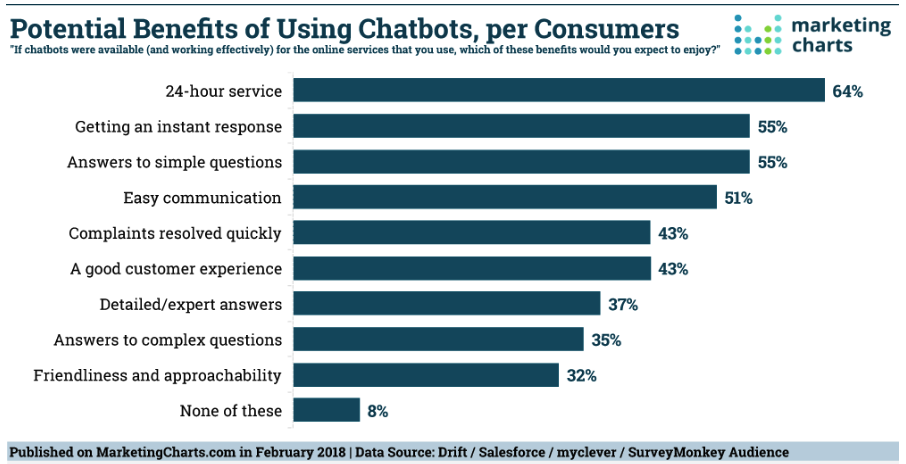

Chatbots are available to respond to customers in the middle of the night as well as on weekends.
That’s because chatbots don’t need to eat, sleep, or take bathroom breaks.
We recommend that you maximize your availability and provide 24-hour service to your customers, whether that be with a chatbot/virtual assistant or a live chat provider.
Live chat services are also able to offer 24/7 coverage, but at different prices depending on the provider.
Here at ApexChat, we offer multiple chat agents 24/7 so when your web traffic spikes, our team of chat agents has you covered at all hours of the day and night.
Schedule a demo with us today to learn how you can add live chat or virtual assistants to your website.
While speed is important, customers want the right answer at any time of the day or night.
Speed is useless if the customer inquiry isn’t resolved.
The whole point of reaching out is to provide an answer to the customer’s question or a problem that needs to be addressed.
While human representatives are usually the best at solving a customer’s problem, chatbots are usually able to get the job done in specific instances.
Research shows that eight out of ten chat sessions can be resolved by a chatbot.
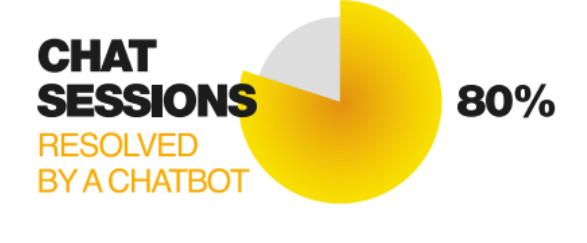

80% is good, but chatbots aren’t perfect: 20% of these sessions don’t end in a resolution.
The fact of the matter is that it’s nearly impossible to please 100% of your customers. However, you want to try and get that number as close to 100% as possible.
In specific instances, chatbots can transfer the conversation to a customer service representative.
Those agents can take over and finish the task that the chatbot wasn’t able to accomplish. Human touch is invaluable in these instances.
As we’re said before, chatbots cannot feel empathy or convey a specific tone to the customer the same way a human can.
A chatbot won’t give customers the right response if it doesn’t understand what they’re asking.
Here’s an example of that:
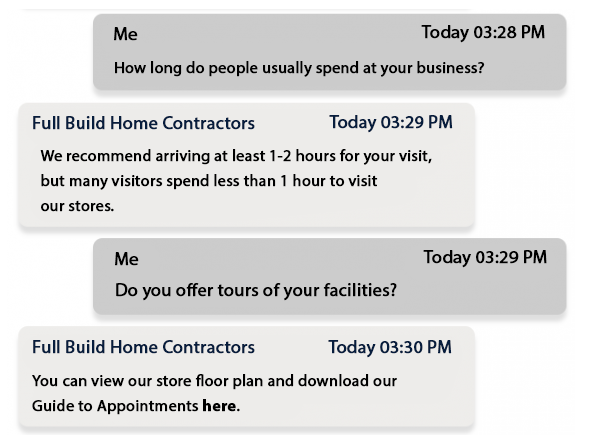

As you can see, the chatbot example here provides useful information.
The first question is answered appropriately, but the second question doesn’t get answered properly.
Chatbots may also have problems interpreting the customer’s query if it has spelling and grammar issues.
Another example of this could be if a customer is looking for help with something like custom pricing based on their businesses unique situation. A chatbot likely will not be able to provide them with the assistance an actual person could provide.
Can a chatbot resolve customer inquiries? Absolutely. But sometimes you’ll need to transfer those chats to a human to ensure they get the answers they need.
The end goal is to have your customers convert after reaching out to your customer support via whatever option they choose.
The great thing about live chat is that it increases the chances that people will buy from your business:
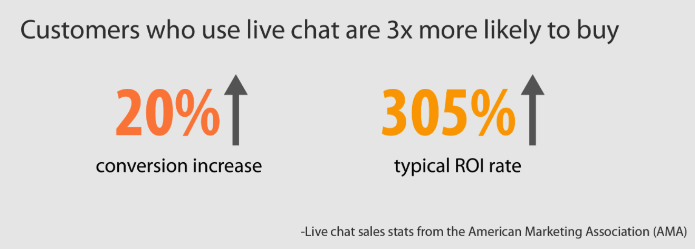

Live chat is a great way to drive conversions. However, live chat isn’t as proactive as a chatbot would be. Allow us to explain.
Once your website visitor determines they want to use live chat to solve their problem, they need to make the decision to reach out. As a result of the conversation they have with your agent, they’ll be more likely to convert.
The key here is that the visitor needs to make that initial step of starting a chat.
It’s unreasonable for a human live chat agent to reach out to every single person who lands on your website.
That’s when you can use a chatbot to be proactive and start the conversation for the customer. Here’s an example from our virtual assistant:
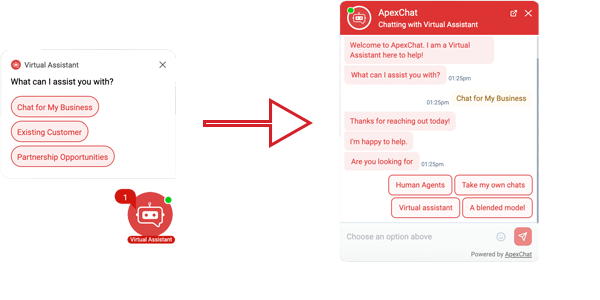

When a customer lands on your website, an AI chatbot will automatically start a chat session.
This is what we mean by proactive. Now, if a customer has an inquiry, they’ll be more inclined to take advantage of this feature since it’s all being done for them.
If the chatbot is unable to resolve the problem, the chat can be transferred to a human representative for additional help.
Your business can and should provide better customer service by implementing live chat.
All you need to determine is whether you’re going to use human agents or chatbots to handle this type of communication.
Chatbots will provide an instant response for website visitors, but live chat agents are still faster than other current methods of customer support like phone, email, and SMS.
Live chat representatives are less expensive than phone call services from customers, but chatbots will be cheaper for your business in the long run.
However, chatbots don’t empathize the same way as human agents during conversations with customers.
Chatbots and most live chat services are available 24/7, but pricing will vary depending on what your business needs.
Chatbots have a surprisingly high success rate at resolving most customer inquiries. But both live chat agents and chatbots increase the chances of getting customers to convert.
Our conclusion is that live chat and chatbots work best when they’re implemented together.
We recommend you use a service that offers both of these on your website to maximize efficiency, conversions, and customer experiences to get the best results.
We’re here to help you generate more qualified leads for your business. We’ve put together our best tips on live chat pricing, becoming a white label live chat reseller, and how to set up live chat on your website.
Learn more about our story here.